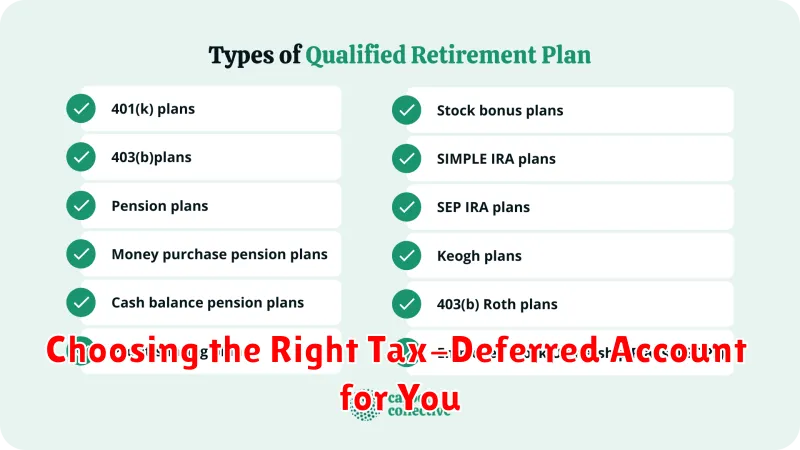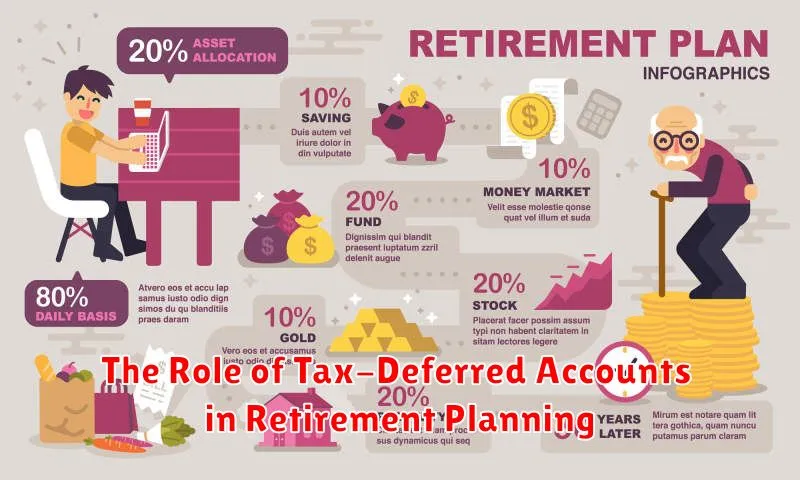Saving for retirement can seem daunting, but there are powerful tools available to help you reach your financial goals. One such tool is the tax-deferred retirement account, which allows you to grow your savings tax-free until retirement. This means you’ll pay less in taxes over the long term, potentially boosting your nest egg significantly.
While the concept of tax-deferred retirement accounts is appealing, understanding how to maximize their benefits can be tricky. In this article, we’ll break down the key aspects of these accounts, including the different types available, how to choose the right one for you, and strategies for maximizing your contributions and investment growth. By the end, you’ll have a clear understanding of how to take advantage of tax-deferred retirement accounts and build a secure financial future for yourself.
What are Tax-Deferred Retirement Accounts?
Tax-deferred retirement accounts, also known as qualified retirement plans, offer a valuable opportunity to save for retirement while minimizing your current tax burden. These accounts allow you to contribute pre-tax dollars, meaning you don’t pay taxes on the money until you withdraw it during retirement. This can result in significant tax savings over the years.
There are several types of tax-deferred retirement accounts, including 401(k)s, 403(b)s, traditional IRAs, and Roth IRAs. Each type has its own contribution limits, eligibility requirements, and withdrawal rules.
The main benefit of tax-deferred accounts is the tax deferral. Instead of paying taxes on your contributions immediately, you pay them upon withdrawal during retirement, when your tax bracket may be lower. This allows your savings to grow tax-free, potentially boosting your overall retirement nest egg.
However, it’s important to note that withdrawals from tax-deferred retirement accounts are typically taxed as ordinary income. Additionally, there may be penalties for withdrawing funds before reaching retirement age, except in certain circumstances.
Tax-deferred retirement accounts can be a powerful tool for building a secure financial future. By understanding the different types of accounts and their rules, you can choose the option that best suits your individual circumstances and retirement goals.
Types of Tax-Deferred Retirement Accounts (401(k), IRA, etc.)
Tax-deferred retirement accounts allow you to save for retirement while deferring taxes on your contributions and earnings until you withdraw the money in retirement. This can be a powerful tool for building wealth over the long term. There are several types of tax-deferred retirement accounts available, each with its own rules and regulations. Here’s a breakdown of some of the most common options:
401(k)s
A 401(k) is a retirement savings plan offered by employers. It allows employees to contribute a portion of their pre-tax salary to the plan, which is then invested in a variety of investment options. You can choose to contribute a percentage of your paycheck or a fixed dollar amount. Your contributions reduce your taxable income, which can result in significant tax savings.
There are two main types of 401(k) plans: traditional and Roth. With a traditional 401(k), you don’t pay taxes on your contributions until you withdraw the money in retirement. This can be beneficial if you expect to be in a lower tax bracket in retirement than you are now. With a Roth 401(k), you pay taxes on your contributions upfront, but your withdrawals in retirement are tax-free. This can be beneficial if you expect to be in a higher tax bracket in retirement than you are now.
Individual Retirement Accounts (IRAs)
An IRA is a retirement savings plan that individuals can set up on their own. It allows you to contribute a portion of your income to the plan each year. You can choose to contribute to a traditional IRA or a Roth IRA.
With a traditional IRA, you don’t pay taxes on your contributions until you withdraw the money in retirement. With a Roth IRA, you pay taxes on your contributions upfront, but your withdrawals in retirement are tax-free. The contribution limits for traditional and Roth IRAs are the same, but the rules governing eligibility, income limits, and distribution vary. There are also other types of IRAs, such as SEP IRAs and SIMPLE IRAs, which are specifically designed for self-employed individuals and small business owners.
Other Tax-Deferred Retirement Accounts
In addition to 401(k)s and IRAs, there are other types of tax-deferred retirement accounts available, including:
- 403(b) plans, which are similar to 401(k) plans but are offered by non-profit organizations and educational institutions.
- 457 plans, which are offered to state and local government employees.
These plans offer similar benefits to 401(k)s and IRAs, such as tax-deferred growth and tax-free withdrawals in retirement.
Benefits of Tax-Deferred Retirement Accounts
Tax-deferred retirement accounts offer a significant advantage for individuals seeking to grow their retirement savings. The core benefit lies in the deferral of taxes on both contributions and earnings until retirement. This allows your money to compound tax-free, potentially leading to significantly higher balances compared to taxable investment accounts. Let’s delve into the key advantages:
Tax-Free Growth: One of the most compelling aspects of tax-deferred accounts is the ability for your investments to grow tax-free. This means that your earnings are not taxed annually, unlike in taxable accounts. This allows your savings to compound at a faster rate, maximizing your potential retirement nest egg.
Lower Tax Liability: By deferring taxes until retirement, you can potentially benefit from lower tax brackets. During your working years, you may be in a higher tax bracket, but your retirement years may see a decrease in income and, therefore, a lower tax bracket. This could result in significant tax savings when you eventually withdraw your funds.
Tax-Efficient Withdrawals: While traditional IRAs and 401(k)s offer tax-deferred growth, they are subject to taxation upon withdrawal in retirement. However, Roth IRAs, a type of tax-deferred account, allow for tax-free withdrawals in retirement, provided you meet certain requirements. This can be particularly beneficial for those who anticipate being in a higher tax bracket in retirement.
Potential for Deductible Contributions: Depending on the type of tax-deferred account, you may be eligible for a tax deduction on your contributions. Traditional IRAs and 401(k)s often offer this benefit, further reducing your tax burden and increasing your savings potential.
How Tax-Deferred Accounts Impact Your Tax Liability
Tax-deferred accounts, like 401(k)s and traditional IRAs, offer a significant advantage by delaying tax payments on your investment earnings until retirement. This means that while you’re contributing to the account, you’re not taxed on those contributions or the subsequent earnings. This can be a powerful tool for saving for retirement, as it allows your money to grow tax-free for a longer period.
However, it’s important to understand that you will eventually have to pay taxes on the money you withdraw from a tax-deferred account in retirement. This is because the earnings are not taxed until you withdraw them. This can have an impact on your tax liability in retirement, especially if you are in a higher tax bracket than you were when you made the contributions.
Despite the eventual tax liability, the benefits of tax-deferred accounts can outweigh the downsides. For instance, during your working years, you may have a lower tax burden, allowing you to contribute more to your retirement savings. Additionally, the tax deferral helps your savings grow faster than they would in a taxable account.
Therefore, it’s important to carefully consider your individual financial situation and tax implications when deciding if a tax-deferred account is right for you. Consult with a financial advisor to help you determine the best strategy for maximizing your retirement savings while managing your tax liability effectively.
Contribution Limits for Tax-Deferred Accounts
One of the biggest advantages of tax-deferred retirement accounts is the ability to save a significant amount of money for retirement. But there are limits on how much you can contribute each year. These limits are set by the government and are adjusted annually for inflation.
For 2023, the contribution limit for 401(k) plans is $22,500. If you are 50 or older, you can contribute an additional $7,500 as a catch-up contribution. The contribution limit for traditional and Roth IRAs is $6,500 in 2023, with an additional $1,000 catch-up contribution for those 50 and older.
It is important to note that these are just the contribution limits. You may also have other limits on how much you can contribute, such as your employer’s 401(k) plan limit.
If you are unsure about your contribution limits, it is best to consult with a financial advisor.
Investment Options Within Tax-Deferred Accounts

Tax-deferred retirement accounts, such as 401(k)s and IRAs, offer a valuable opportunity to grow your wealth over time. They allow you to contribute pre-tax dollars, which means you won’t have to pay taxes on your earnings until you withdraw them in retirement. These accounts provide a wide range of investment options, allowing you to tailor your portfolio to your risk tolerance and financial goals.
Here are some common investment options within tax-deferred accounts:
Mutual Funds
Mutual funds are a popular choice for investors who prefer diversification. They pool money from multiple investors to buy a basket of securities, such as stocks, bonds, or a combination of both. This diversification helps to reduce risk, as the performance of any one security won’t significantly impact your overall portfolio.
Exchange-Traded Funds (ETFs)
ETFs are similar to mutual funds, but they are traded on stock exchanges like individual stocks. They offer a convenient and cost-effective way to invest in a diversified portfolio. ETFs are generally considered to be more tax-efficient than mutual funds.
Individual Stocks
If you have a higher risk tolerance and are comfortable doing your own research, you can invest in individual stocks. This gives you the potential for higher returns, but it also comes with a greater risk of losses.
Bonds
Bonds are debt securities that represent a loan from an investor to a borrower, typically a company or government. Bonds offer a relatively safe and stable investment, but they generally offer lower returns than stocks.
Real Estate Investment Trusts (REITs)
REITs are companies that own and operate income-producing real estate properties. Investing in REITs allows you to gain exposure to the real estate market without having to purchase a physical property.
It’s important to note that investment options may vary depending on your specific retirement account and the provider. Before investing in any option, it’s crucial to understand the risks and potential rewards, and to seek guidance from a financial advisor if needed.
Choosing the Right Tax-Deferred Account for You

There are many different types of tax-deferred retirement accounts available, so it is important to choose one that is right for you. Some of the most popular types of tax-deferred retirement accounts include 401(k)s, 403(b)s, IRAs, and Roth IRAs.
401(k)s are employer-sponsored retirement plans that allow employees to contribute a portion of their pre-tax income to a retirement account. Employers may also match employee contributions to a certain extent. 403(b)s are similar to 401(k)s, but they are offered by non-profit organizations and public schools. IRAs are individual retirement accounts that are available to anyone, regardless of employment status. Roth IRAs are similar to traditional IRAs, but contributions are made with after-tax dollars and withdrawals in retirement are tax-free.
The best tax-deferred retirement account for you will depend on your individual circumstances, such as your age, income, and whether or not you are employed.
If you are employed and your employer offers a 401(k) or 403(b), it is generally a good idea to participate in the plan, especially if your employer offers a match. You should make sure you understand the different options for investing your contributions within the plan, including mutual funds, ETFs, and target-date funds. You should also consider if you want to contribute to the plan pre-tax or after-tax (Roth 401(k)).
If you are self-employed or do not have access to an employer-sponsored retirement plan, a traditional or Roth IRA may be a good option for you. It is important to consider your tax situation when deciding between a traditional and Roth IRA. You should also consider the different investment options available within each type of IRA.
It is important to research all of the different types of tax-deferred retirement accounts available and choose one that is right for you. Consulting with a financial advisor can also help you make the best decision for your retirement planning goals.
Strategies for Maximizing Your Tax-Deferred Savings
Tax-deferred retirement accounts offer a powerful tool to grow your wealth for retirement. But simply contributing to these accounts isn’t enough to truly maximize their potential. Here are some strategic approaches to help you make the most of your tax-deferred savings:
Contribute the Maximum Allowed: Take advantage of the full contribution limits offered by your chosen accounts, like 401(k)s and IRAs. Maximize these contributions early on, as compounding interest works its magic over time. Many employers also offer matching contributions, essentially giving you free money to boost your retirement savings.
Consider a Roth Conversion: If you’re in a lower tax bracket now than you expect to be in retirement, consider converting some of your traditional IRA savings to a Roth IRA. This allows you to withdraw funds tax-free in retirement, potentially saving you significant taxes down the line.
Invest Wisely: Choosing the right investments within your tax-deferred accounts is crucial. Aim for a diversified portfolio with a mix of stocks, bonds, and other assets. This helps manage risk and potentially increase your returns over the long term. Consider seeking professional advice if needed to create an investment strategy that aligns with your risk tolerance and financial goals.
Take Advantage of Catch-Up Contributions: Individuals aged 50 and older can contribute extra to their 401(k)s and IRAs each year. This “catch-up” contribution provides a valuable opportunity to boost your savings in later years.
Avoid Early Withdrawals: While tempting, withdrawing funds from your tax-deferred accounts before retirement usually comes with penalties. Plan your expenses carefully and try to minimize these withdrawals to preserve your retirement nest egg.
Remember, consistency is key. Even small contributions over time can add up significantly thanks to the power of compound interest. By implementing these strategies, you can optimize your tax-deferred retirement savings and set yourself up for a comfortable and secure retirement.
Understanding Required Minimum Distributions (RMDs)
Required Minimum Distributions (RMDs) are mandatory withdrawals you must take from your retirement accounts, such as 401(k)s and traditional IRAs, starting at age 72 (or 70 1/2 if you turned 70 1/2 before January 1, 2020). The amount you need to withdraw each year is calculated based on your account balance and life expectancy.
RMDs are designed to ensure that retirement savings are used to provide income during retirement. Failing to take your RMDs can result in hefty penalties.
Here’s a breakdown of what you need to know about RMDs:
- When RMDs start: You must begin taking RMDs from your retirement accounts in the year you turn 72. However, if you are still working at age 72 and you are the owner of a 401(k), you can delay taking RMDs until you retire or leave that job.
- How to calculate RMDs: You can use the IRS’s online calculator or work with a financial advisor to determine your RMD. Your account provider can also help you calculate this amount.
- Tax treatment: RMDs are taxable income, and the amount you withdraw will be taxed as ordinary income in the year you receive it.
- Penalties: If you don’t withdraw your full RMD, you could be subject to a 50% penalty on the amount you should have withdrawn. However, the penalty is waived if you meet specific requirements.
While RMDs may seem like a burden, they can also provide a valuable opportunity for tax planning. By understanding how RMDs work, you can plan ahead and minimize your tax liability in retirement.
Penalties for Early Withdrawals
While tax-deferred retirement accounts offer significant tax advantages, it’s important to understand the potential consequences of early withdrawals. If you withdraw funds from your retirement account before age 59 1/2, you’ll typically face a 10% penalty, in addition to your usual income tax.
However, there are some exceptions to this rule, such as:
- First-time homebuyer: You can withdraw up to $10,000 penalty-free for a first-time home purchase.
- Higher education expenses: You can withdraw funds penalty-free for qualified education expenses for yourself or your dependents.
- Certain medical expenses: If you incur significant medical expenses, you may be eligible for a penalty-free withdrawal.
- Disability: You may be able to withdraw funds penalty-free if you are disabled.
- Death: If you die, your beneficiaries can inherit the funds without penalty.
It’s essential to consult with a financial advisor or tax professional to determine whether you qualify for an exception. Carefully consider the potential tax implications before making any withdrawals from your retirement account.
The Role of Tax-Deferred Accounts in Retirement Planning

Tax-deferred accounts play a crucial role in retirement planning by allowing you to accumulate wealth tax-free until retirement. These accounts, such as 401(k)s and IRAs, let you invest your money and watch it grow without paying taxes on the earnings until you withdraw them in retirement. This can significantly enhance your retirement savings potential, as you won’t be losing money to taxes each year.
One major advantage of tax-deferred accounts is the benefit of compound interest. Since your earnings are not taxed immediately, they can be reinvested, generating even more returns. This compounding effect can work wonders in the long run, allowing your savings to grow exponentially.
Furthermore, tax-deferred accounts can provide valuable tax benefits during retirement. When you withdraw your funds in retirement, you’ll likely be in a lower tax bracket than you were during your working years. This means you may pay lower taxes on your withdrawals, ultimately leaving you with more money to enjoy in retirement.
Seeking Advice from a Financial Advisor

While learning about tax-deferred retirement accounts is a great first step, it’s crucial to understand that this information may not be enough to make informed decisions about your individual financial future. Every individual has different financial goals, risk tolerance, and income levels. To get the most out of these accounts, it’s highly recommended that you consult with a qualified financial advisor.
A financial advisor can provide personalized guidance tailored to your specific circumstances. They can help you:
- Determine the best types of tax-deferred accounts for your needs, such as 401(k)s, 403(b)s, IRAs, or Roth IRAs.
- Create a retirement savings plan that aligns with your goals and time horizon.
- Select investments that match your risk tolerance and investment objectives.
- Optimize your tax strategies to maximize your retirement savings.
- Provide ongoing support and guidance as your financial situation evolves.
A financial advisor can help you navigate the complexities of retirement planning and ensure you are making the most informed decisions for your financial future.

